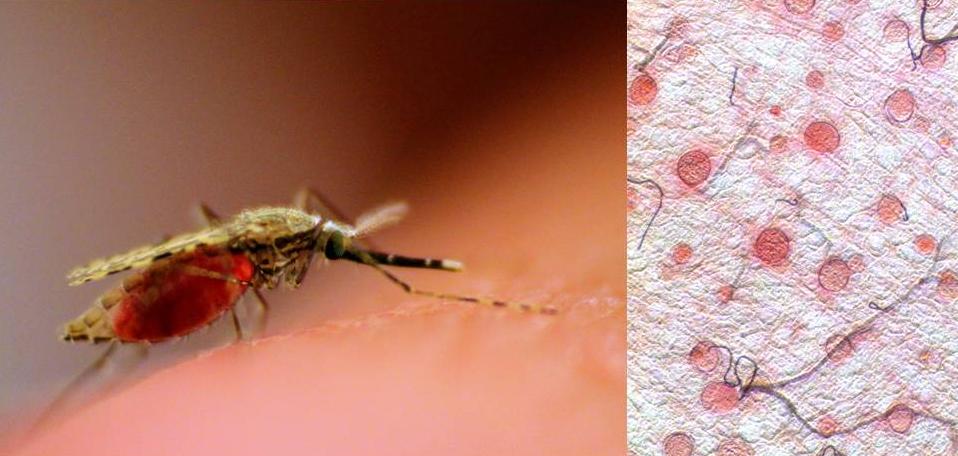Fighting Malaria, With a Little Help from Bacteria
Posted on by Dr. Francis Collins

Caption: Anopheles female blood feeding and Plasmodium falciparum eggs in Anopheles mosquito midguts.
Credit: Image courtesy of Jose Luis Ramirez, Laboratory of Malaria and Vector Research, NIAID, NIH
It turns out that one of the most innovative and effective strategies to fight malaria might involve harnessing a bacterium called Wolbachia. This naturally occurring genus of bacteria infects many species of insects, including mosquitoes. The reason this is important is that Wolbachia-infected mosquitoes become resistant to the parasite Plasmodium falciparum, which causes some 219 million cases of malaria worldwide and more than 660,000 deaths NIAID, NIH" target="_blank">[1]. Wouldn’t it be amazing if Wolbachia-infected mosquitoes blocked the transmission of malaria?
Unfortunately, Wolbachia don’t normally pass from generation to generation in Anopheles, the mosquitoes that spread malaria. But that hurdle has now been overcome.
A team of NIH-funded researchers discovered that when a specific strain of Wolbachia, called wAlbB Wolbachia, was introduced into Anopheles stephensi—the major malaria-transmitting mosquito species in the Middle East and South Asia—it was passed down from generation to generation. In lab experiments, when just 5% of female mosquitoes were infected with wAlbB Wolbachia, researchers saw the bacteria spread to all the mosquitoes after just 8 generations [2].
Wolbachia likely makes the mosquito spew out a cocktail of toxic molecules called reactive oxygen species that kills the malaria parasites as it develops in mosquitoes’ mid-gut and salivary glands. That’s pretty cool—we’re basically using one microorganism to kill another.
This work suggests a potentially powerful public health intervention. Mosquitoes infected with wAlbB Wolbachia could be released in a region where malaria is endemic. These wAlbB Wolbachia mosquitoes would mate with the local mosquitoes. Their progeny would all carry the bacterium and be resistant to the malaria parasite. Eventually, wAlbB Wolbachia mosquitoes would replace the native population. It could be a very effective strategy, particularly for regions like sub-Saharan Africa where malaria claims the most victims.
This approach is promising and has already been tested on a small scale. In an Australian field trial, researchers successfully spread Wolbachia in another mosquito, Aedes aegypti, which transmits a disease called dengue fever. Wolbachia-infected mosquitoes infiltrated the local population and spread the bacteria from one generation to the next. In lab studies, these mosquitoes are resistant to dengue. It’s a clever intervention because the mosquitoes, by spreading Wolbachia, are actually doing all the work of blocking disease transmission.
Resources:
[1] Malaria Facts. (CDC)
[2] Wolbachia invades Anopheles stephensi populations and induces refractoriness to Plasmodium infection. Bian G, Joshi D, Dong Y, Lu P, Zhou G, Pan X, Xu Y, Dimopoulos G, Xi Z. Science. 2013 May 10;340(6133):748-51.
NIH support: National Institute of Allergy and Infectious Diseases

fascinating
thanks for sharing. i like your post because it is very-very good.
Such research results and approaches to disease control certainly are interesting. I am sure scientists doing such field tests also have studied the long time effects and possible side effects on other parts of nature when spreading bacteria in an artificial way across God’s creation on earth.
To fight disease with another disease (bacteria) is one of several possible approaches – other options may be found and tested as well.
Some 4 decades ago, while working in Africa (Zaire) for an NGO I got 12 times Malaria (11x M. vivax and 1x M. troipca), and the treatment was only partially successful. What finally stopped the cycle of re-occurrences of Malaria in my life was will power and nature – no medicine. How that worked I have no idea – but it worked while all medical treatment just affected and troubled my eyes and vision.
A substantial reduction of mosquitoe larvae also could be accomplished by inserting Tilapia fish into rice fields of S.E Asia and similar countries. Fast growing and feeding on almost anything – the substantial reduction of mosquitoe larvae surely decreases the number of flying Mosquitoes and thus the risk of spreading Malaria.
One illness – many possible approaches. Some natural approaches, some artificial ones like the one mentioned above.